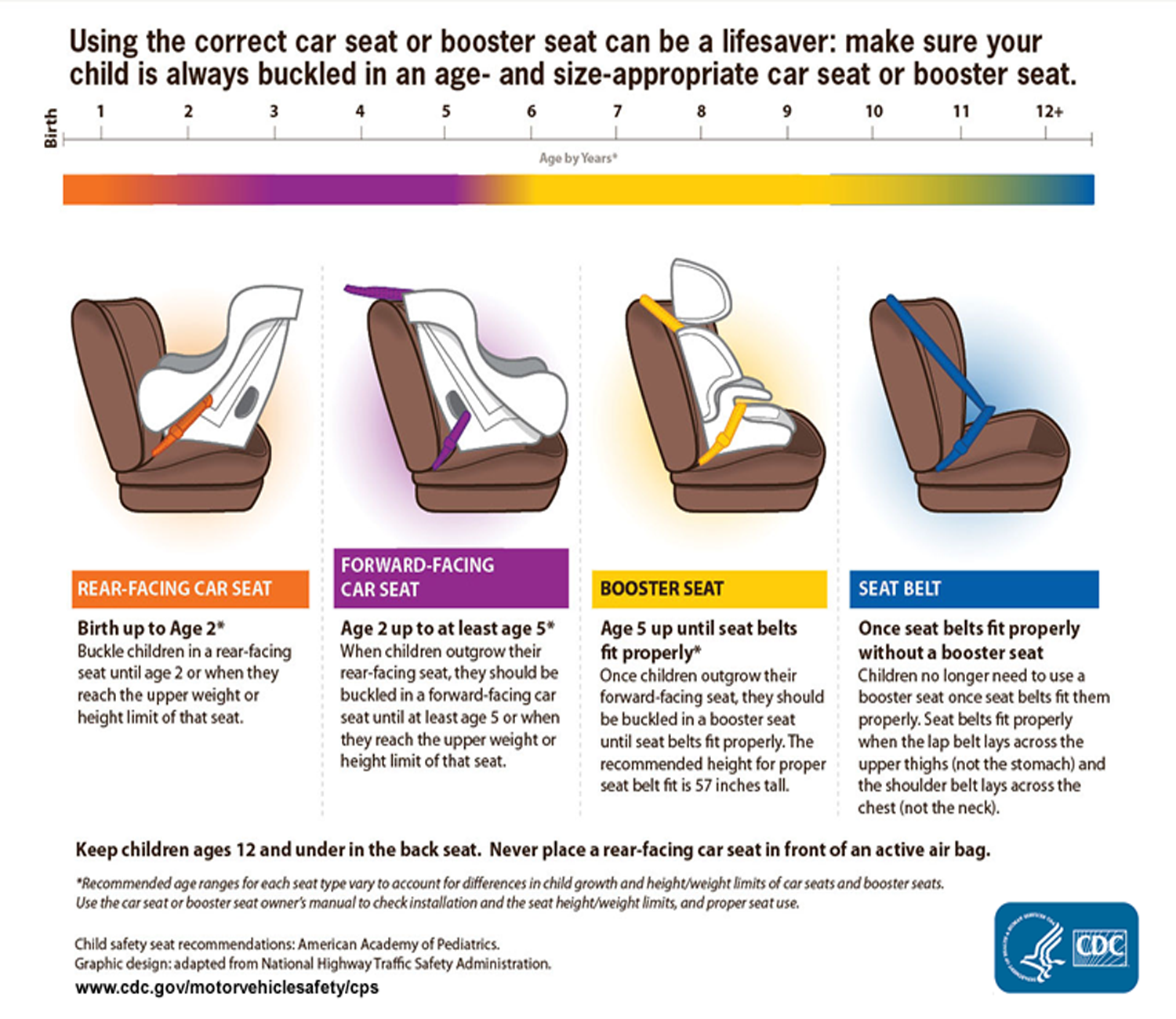410-721-2273
Car Safety Seats
Each year thousands of young children are killed or injured in car crashes. Proper use of car safety seats can reduce traffic fatalities by at least 80%. All 50 states have passed laws that require children to ride in approved child passenger safety seats.
A parent cannot protect a child by holding him or her tightly. In a 30-mile-per-hour crash, the child will either be crushed between the parent's body and the dashboard or ripped from the parent's arms and possibly thrown from the car. Car safety seats also help to control a child's misbehavior, prevent motion sickness, and reduce the number of accidents caused by a child distracting the driver.
What are the types of car safety seats?
Before you buy a car safety seat, look at several different models. Make sure that the car seat will fit in your car and that your seat belts will work with the seat. There are several types of car safety seats:
- Infant-only seats: These are rear-facing only seats. They can be used from birth until a child weighs 22 to 40 pounds (depending on the model). They are small and portable. Most seats come with a detachable base that stays in the car. This allows you to easily snap the car seat in and out of the car without reinstalling the car seat each time. These should only be used for traveling and not other activities such as sleeping, feeding, or anything else outside the vehicle.
- Convertible safety seats: These seats can be used in both rear- and forward-facing positions. The seat needs to stay in the rear-facing position until your child is at least 2 years of age or reaches the highest weight or height by the car seat manufacturer. Children who have outgrown the rear-facing weight or height limit for their convertible car seat should then use a convertible seat in the forward-facing positions for as long as possible, up to the highest weight or height allowed by the car seat manufacturer.
- 3-in-1 seats: These seats are forward-facing seats that can be used after your child has reached 20 pounds and is at least 1 year old. Your child must wear the 5-point harness until he or she has reached 40 pounds. When your child is over 40 pounds, you can use this seat as a booster seat by correctly positioning the car's lap/shoulder belt across your child. It can be used as a booster seat until your child is about 80 pounds (depending on the model). These seats can be used rear-facing, forward-facing, or as a belt-positioning booster. This means the seat may be used longer by your child as your child grows. Because they are often bigger in size, it is important to check that they fit in the vehicle while rear-facing. Although they do not have the convenience of a carrying handle or separate base; they may have higher limits in rear-facing weight (up to 40–50 pounds) and height than rear-facing–only seats, which make them ideal for bigger babies and toddlers.
- Booster seats: All children whose weight or height exceeds the forward-facing limit for their car safety seat should use a belt-positioning booster sear until the vehicle’s seat belt fits properly. They do not come with harness straps but are used with lap and shoulder seat belts in your vehicle, the same way an adult rides. Most booster seats are not secured to the vehicle seat with the seat belt or lower anchor and tether but simply rest on the vehicle seat and are held in place once the seat belt is fastened over a child. Booster seats are to be used until your child reaches 4 feel 9 inches in height and are 8 to 12 years old. All children younger than age 13 should ride in the back seat. A high-back booster seat provides additional support.
- Built-in seats (integrated seats): Some cars and vans come with built-in child safety seats. These may be used by children who are over 1 year of age and weigh at least 20 pounds. Weight and height requirements vary depending on the car manufacturer. Check with the maker of the car to find out the specific height and weight requirements.
Keep car seat instructions in a safe spot, such as taped to the back of the seat. Send product information to the manufacturer to make sure you are notified of any safety recalls. Contact the manufacturer if you need a new instruction manual.
How to use different types of car seats
Rear-Facing Seats
- Place the harnesses in your rear-facing seat in slots that are at or below your baby's shoulders.
- Ensure that the harness is snug (you cannot pinch any slack between your fingers when testing the harness straps over the baby's shoulders) and that the harness chest clip is placed at the center of the chest, even with your child's armpits.
- Make sure the car seat is installed tightly in the vehicle with either LATCH or a locked seat belt. If you can move the seat at the belt path more than an inch side to side or front to back, it's not tight enough.
- Never place a rear-facing seat in the front seat of a vehicle that has an active front passenger airbag. If the airbag inflates, it will hit the back of the car seat, right where your baby's head is, and could cause serious injury or death.
- If you are using a convertible or 3-in-1 seat in the rear-facing position, make sure the seat belt or lower anchor webbing is routed through the correct belt path. Check the instructions that came with the car seat to be sure.
- Make sure the seat is at the correct angle so your infant's head does not flop forward. Check the instructions to find out the correct angle for your seat and how to adjust the angle if needed. All rear-facing seats have built-in angle indicators or adjusters.
- Check the car seat instructions and vehicle owner's manual about whether the car seat may contact the back of the vehicle seat in front of it.
- Still having trouble? Check with a CPST in your area who can help. See the end of this article for information on how to locate a CPST.
- Watch the Video: How to Install a Rear-Facing Car Seat
Front-Facing Seats
- Move the shoulder straps to the slots that are at or above your child's shoulders. On some convertible seats, the top harness slots must be used when facing forward. Check the instructions that came with the seat to be sure.
- You may have to adjust the recline angle of the seat so that it sits more upright in your vehicle. Check the instructions to be sure.
- If using a seat belt, make sure it runs through the forward-facing belt path (be sure to follow car seat instructions) and that the seat belt is locked and tightened.
- If using the lower anchors, make sure that the weight of your child plus the weight of the seat does not exceed 65 pounds. Most seats now state the maximum child weight to use the anchors in the manual and on the stickers on the side. If the child weighs too much, families must use the seat belt to install.
- Always use the top tether when you can. A tether is a strap that is attached to the top part of a car seat and holds the seat tightly by connecting to an anchor point in your vehicle (often on the seat back or rear shelf; see your vehicle owner's manual to find where tether anchors are in your vehicle). Tethers give important extra protection by keeping the car seat and your child's head from moving too far forward in a crash or sudden stop. All new cars, minivans, and light trucks are required to have tether anchors as of September 2000. Forward-facing seats come with tether straps. A tether should always be used as long as your child has not reached the top weight limit for the tether anchor.
- Check the car seat instructions and vehicle owner's manual for information about the top weight limit and locations of tether anchors.
- Watch the Video: How to Install a Forward-Facing Car Seat
Booster seats
- The lap belt lies low and snug across your child's upper thighs.
- The shoulder belt crosses the middle of your child's chest and shoulder and is off the neck.
- Watch the Video: How to Use a Booster Seat
What is LATCH?
Starting in 2002, most new vehicles and car safety seats came equipped with a new system called LATCH (Lower Anchors and Tethers for Children). This system may be an easier way to attach safety seats. It allows you to attach the car seat without using a seat belt. However, you will need to continue attaching the car safety seat with a seat belt unless you have both a new car seat and a new car with the LATCH system.
What are tethers?
Tether straps are found on most new forward-facing car seats. A tether strap hooks the top of a car safety seat to a permanent anchor in the car to provide extra protection. Tethers reduce the amount of forward movement of the car seat in a crash. Check your car to see if it has an anchor. Cars made since September 2000 are required to have tether anchors. Cars made since 1989 can be retro-fitted with tether straps. Most anchors are on the rear window ledge, back of the seat, floor, or ceiling of the car. There are tether kits available for older car seats. Check with your car seat and car manufacturer.
Where should the car seat be placed?
Whenever possible and at any age, put the safety seat in the middle back seat of the car, which is much safer than the front seat.
Air bags are standard equipment in most new cars. They have saved many lives. However, they are very hazardous to infants in REAR-facing child safety seats and have caused death from brain injury. If your car has air bags, take the following precautions:
- Infants riding in REAR-facing child safety seats should NEVER be placed in the front seat of a car or truck with a passenger-side air bag. They must be in the car's rear seat or not ride in that vehicle.
- Children in FORWARD-facing child safety seats should also ride in a car's rear seat until 13 years of age.
- If the vehicle does not have a rear seat, children riding in the front seat should be positioned as far back as possible from the air bag. Move the seat all the way back so that the child is as far as possible from the dashboard. Some cars come with air bag ON/OFF switches. Turn the air bag off only if your car has no back seat.
- Side air bags improve safety for adults in side impact crashes. However, children who are seated near a side air bag may be at risk for serious injury. Read your vehicle owner's manual to find out how this applies to your vehicle.
If you have more questions about installing your car safety seat, a list of inspection stations where you can go for help is available in both English and Spanish at http://www.seatcheck.org or toll-free at 866/SEATCHECK (866/732-8243).
When can my child use a regular seat belt?
Keep your child in a booster seat as long as possible. Your child could be ready for a regular seat belt anywhere between 8 and 12 years old depending on height and weight. Your child should be 4' 9" tall and at least 60 to 80 pounds to properly fit an adult seat belt. When your child is ready for a regular seat belt, use a lap belt low across the thighs. If your child is using a shoulder belt, it should cross your child's chest, not the neck or throat. Never put the shoulder belt under both arms or behind the back.
What are the safety standards?
The American Academy of Pediatrics (AAP) publishes an annual list of infant/child safety seats that have met the Federal Motor Vehicle Standards. Visit their website for the complete list of brands and retail prices.
Each state has its own seat belt laws and safety standards. Although all states require that children are buckled in, not all states require that children travel in the safest way possible. Using a car safety seat correctly is very important. Follow the safety seat instructions and make sure you are keeping your child as safe as possible.
Tips for using a car safety seat properly
If used consistently and properly, your child's car seat can be a lifesaver. Your attitude toward safety belts and car seats is important. If you treat buckling up as a necessary, automatic routine, your child will follow your lead and also accept car seats and seat belts. To keep your child safe and happy, follow these guidelines:
- Always use the safety seat. Use the safety seat on the first ride home from the hospital, and continue using it for every ride.
- Everyone buckles up. Allow NO exceptions for older kids and adults. If adults ride unprotected, the child quickly decides that safety is just kid stuff.
- Give frequent praise for appropriate behavior in the car.
- Remember that a bored child can become disruptive. Keep a supply of favorite soft toys on hand. Use food as a last resort, because they contribute to the unhealthy habit of snacking and overeating.
- NEVER let a fussy child out of the car seat or safety belt while the car is in motion. If your child needs a break, STOP the car. Responding to complaints by allowing your child to ride unprotected is a disastrous decision that will make it harder to keep him or her in the seat on the next ride.
- Parents should never take off their seat belt to reach into the back seat to attend to a child while the car is in motion. Too many parents have been seriously injured when their car was struck during those few seconds.
- Some infants begin crying at 4 or 5 months (possibly from separation anxiety) when placed in their rear-facing car seats. Try distracting them with music and toys. Also give them practice time in the car seat at home. Use it for pleasant activities such as playing and eating.
- If a child tries to get out of the seat, stop the car and firmly but calmly explain that you won't start the car until he or she is again buckled in the car seat.
- Booster seats must be used with a lap/shoulder belt.
- When your child travels in another person's car (such as a baby sitter's or grandparent's car), insist that the driver also use the safety seat.
- For long-distance trips, plan for frequent stops and try to stop before your child becomes restless. Cuddle a young child. Let an older child snack and run around for 10 to 15 minutes.

You May Also Like
Popular Resources | Make an Appointment • Locations • Refill Prescriptions





